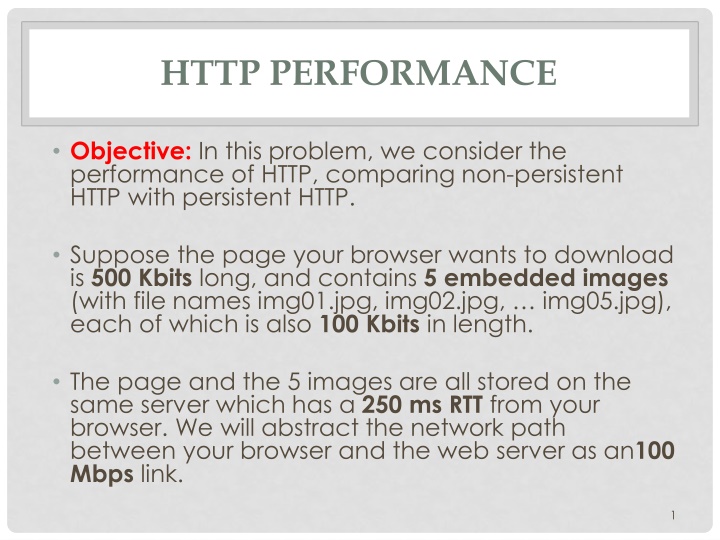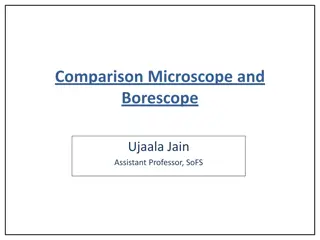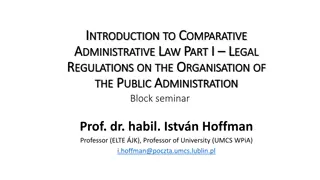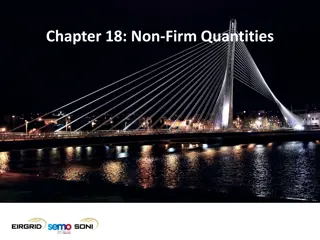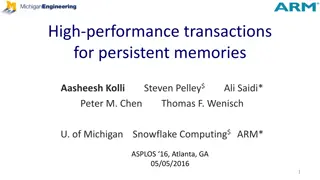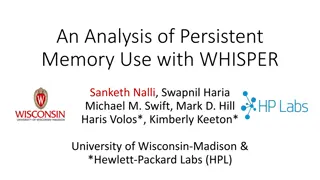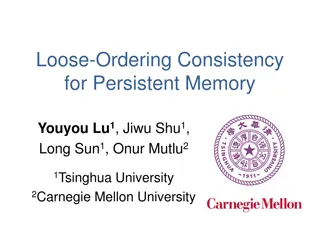Comparison of HTTP Performance: Non-Persistent vs Persistent
This problem explores the performance differences between non-persistent and persistent HTTP connections when downloading a webpage and embedded images. It calculates response times considering factors like transmission delays, RTT, and parallel connections, providing a detailed analysis of the delays contributing to each scenario.
Download Presentation

Please find below an Image/Link to download the presentation.
The content on the website is provided AS IS for your information and personal use only. It may not be sold, licensed, or shared on other websites without obtaining consent from the author.If you encounter any issues during the download, it is possible that the publisher has removed the file from their server.
You are allowed to download the files provided on this website for personal or commercial use, subject to the condition that they are used lawfully. All files are the property of their respective owners.
The content on the website is provided AS IS for your information and personal use only. It may not be sold, licensed, or shared on other websites without obtaining consent from the author.
E N D
Presentation Transcript
HTTP PERFORMANCE Objective: In this problem, we consider the performance of HTTP, comparing non-persistent HTTP with persistent HTTP. Suppose the page your browser wants to download is 500 Kbits long, and contains 5 embedded images (with file names img01.jpg, img02.jpg, img05.jpg), each of which is also 100 Kbits in length. The page and the 5 images are all stored on the same server which has a 250 ms RTT from your browser. We will abstract the network path between your browser and the web server as an100 Mbps link. 1
HTTP PERFORMANCE You can assume that the time it takes to transmit a GET message into the path is zero, but you should account for the time it takes to transmit the base file and the embedded objects into the "link." This means that the server-to-client link has both a 125 ms one-way propagation delay, as well as a transmission delay associated with it. The time needed to setup up TCP connections is 1 RTT. 2
NON PERSISTENT HTTP 1- Assuming non-persistent HTTP (and assuming no parallel connections are open between the browser and server). How long is the response time - the time from the when the user requests the URL to the point in time when the page and its embedded objects are displayed? Make sure you describe the various components that contribute to this delay. 2- Again assume non-persistent HTTP, but now assume that the browser can open as many parallel TCP connections to the server as it wants. What is the response time in this case? 3
SOLUTION 1- The transmission time of the 500 Kbits page = L/R = 500 103/ 100 106 = 5 10-3 =5ms The transmission time of each 100 Kbits image = 100 103/ 100 106 = 10-3 = 1ms The delays associated with this scenario are: = 2*RTT *6 + transmission time for file & images = 2*250*6 + 5ms + (5*1)ms = 3.01 s 4
SOLUTION 2- The delays associated with this scenario are: - 2 RTT for first object + - 2 RTT for all images (parallel) + - transmission time for file + - transmission time for images = 500 ms + 500 ms + 5 ms + 5 ms = 1010 ms = 1.01 s 5
PERSISTENT HTTP 3- Now assume persistent HTTP (i.e., HTTP1.1). What is the response time, assuming no parallel connections? 4- Now suppose persistent HTTP with parallel connections is used. What is the response time? 6
SOLUTION 3- 2RTT for base file + RTT*5 (for the 5 images) + transmission time for file + transmission time for images = 500 + 250*5 + 5 +5 = 1760 ms = 1.76 s 4- 2RTT for the base file + RTT for all images (parallel)+ transmission time for file + transmission time for images = 500 + 250 + 5 + 5 = 76 ms = 0.76 s 7
